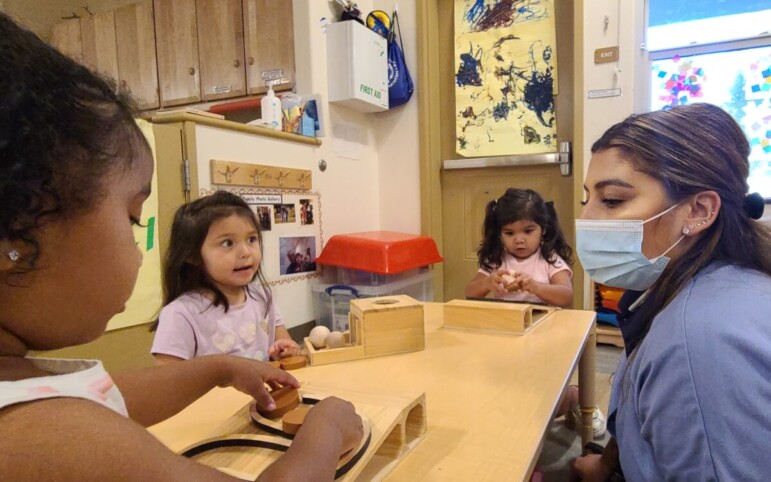Nearly 90% of brain growth happens before children start kindergarten. That’s why experts say high-quality care is so vital for small children. It’s also why the ongoing child care crisis is so worrisome and why the Biden administration is once again trying to address the issue on a national scale.
To be sure, the child care sector has long been marked by a brutal economic tug-of-war. Most families can’t afford the skyrocketing high cost of care, while many child care workers can’t survive on their pay. Note that child care for a baby in Alameda County cost about $20,000 a year in 2021, for example. Now consider that the average child care worker makes about $13 an hour. Raising awareness of this predicament is the goal of events like the upcoming Day without Child Care, when many providers nationwide close down and speak out about the issues.
“Child care is a textbook example of a broken market,” as Secretary of the Treasury Janet Yellen has put it.
“The free market works well in many different sectors, but child care is not one of them. It does not work for the caregivers. It does not work for the parents. It does not work for the kids. And because it does not work for them, it does not work for the country.”
The pandemic has deepened the preexisting child care crisis, shuttering nearly 16,000 child care centers and raising the costs of operation for those that remain in business. Inflation also means everything from masks to snacks costs more than it did before, experts say, while many workers have fled to higher-paying jobs at Starbucks and Target, straining the system further.
Amid the ongoing crisis, the Biden administration initially proposed an ambitious plan for federally subsidized child care that got shot down in Congress. Now he’s pushing several smaller fixes including requiring semiconductor manufacturers that are lining up for a helping of nearly $40 billion in new federal subsidies under the CHIPS and Science Act to provide child care for their workers.
“The pandemic … made it even clearer just how hard it is for millions of working- and middle-class families to provide care for their families,” Biden said last month. “It’s not just how important the care economy is to the entire economy, it’s when people have to leave the labor force or can’t enter it in the first place because of caregiving responsibility, they can’t fully participate in the economy, and that drags down the whole nation’s productivity and growth overall.”

Many laud this strategy for creating more affordable child care options by enticing corporations into providing coverage for their employees.
“Innovative ideas like the CHIPS Act are what we need to begin to address the child care crisis that is generations in the making,” said Gina Fromer, president and CEO of Children’s Council of San Francisco. “Semiconductor industry groups and even leading CEOs are coming out in support of the program’s effort to tie workforce development to child care, citing the need to re-engage the 2 million women that left the workforce during the pandemic to care for family members.”
However, others warn that tying child care to employment instead of treating it as a public good, like K-12 education, risks leaving millions of struggling families out of the loop. Think health care. When you lose your job, you also lose your coverage, as do your kids. These people say it should be the government’s role to oversee vital social infrastructure.
“Kudos for a creative idea, but isn’t the child care system complicated enough without now adding a health care-styled system to layer on top?” said Scott Moore, head of Kidango, a nonprofit organization that runs many Bay Area child care centers. “Another downside is shifting the responsibility from government to business.”
Biden also recently issued an executive order directing federal agencies to find ways to make child care cheaper and more accessible. White House officials have described it as the most sweeping effort by any president to streamline the delivery of child care.
However, some suggest that the strategy of privatizing some of the high costs of child care may prove to be a more practical move.
“Biden’s push on chipmakers to expand their own child care centers as they recruit new workers may prove more consequential,” said Bruce Fuller, professor of education and public policy at UC Berkeley. “The president could double down and press for similar provisions within the $1.2 trillion in infrastructure projects — benefiting a variety of energy, bridge-building and construction firms — all of which employ parents with young children.”
While many child care advocates believe that universal early education should be the gold standard, some suggest economic and political complications may make that goal hard to achieve.
“Early education advocates must continue to push our local, state and national leaders towards the ultimate goal of universal child care for all. That should be our end game, period,” said Fromer.
“But, as with any large-scale socioeconomic change, it has been and will continue to be a long, hard battle to get there. In the meantime, what may feel like short-term, incremental steps have proven to be real solutions.”
Another key issue is how to lift child care workers out of poverty while simultaneously making care more accessible. The child care industry, a workforce with a significant number of women of color, has long been burdened by poverty wages.
“Early childhood teachers work with children during their most formative years of development and growth,” said Moore, “yet they are the lowest paid in a low-pay profession.”
Others warn that maintaining a high quality of care is the bottom line. Simply expanding access to child care or lowering its costs is not enough to give children the head start they need in early childhood.
“One concern: We don’t want to expand the number of new child care slots with static funding,” said Fuller. “This would erode the quality of teachers and raise class size in pre-K programs. The long-term benefits of child care only materialize with high-quality programs.”
